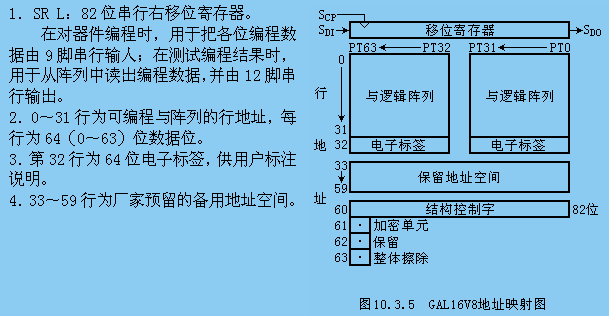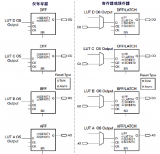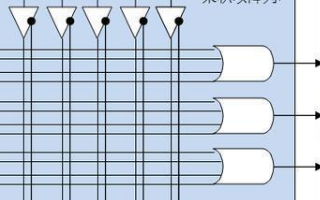隨著可編程邏輯器件的發展,FPGA的應用已經越來越廣泛,且用可編程邏輯器件代替傳統的普通集成電路已成為一種發展的趨勢。可編程邏輯器件FPGA以其高集成度、高速度、開發周期短、穩定性好而受到了人們
2021-01-04 10:36:00 2066
2066 
本章小結第8章 Xilinx可編程邏輯器件設計技巧8.1 概述8.2 可編程邏輯器件的時鐘設計8.3 同步設計與提高器件工作速度8.4 存儲器設計8.5 可編程邏輯器件FPGA的配置8.6
2012-02-27 14:43:30
可編程邏輯器件到底是干什么用的呢,簡單的說,就是通過重新寫程序,重新注入到這個器件中達到實現其它的功能。最常見的當屬電腦了。電腦本身除了加法,減法和簡單的邏輯運算四種。比如要是想實現一個功能讓電腦
2014-04-15 10:02:54
可編程邏輯器件FPGA/CPLD結構與應用.ppt
2017-01-21 20:34:49
可編程邏輯器件(prog ramm able logic device,PLD)件的功能不是固定不變的,它可根據用戶的需要而進行改變,即由編程的方法來確定器件的邏輯功能。可編程邏輯器件自 20 世紀
2019-02-26 10:08:08
芯片上,就可以得到一塊專用集成電路。1.1 可編程邏輯器件可編程邏輯器件PLD(Programmable Logic Device)就是一種可以由用戶定義和設置邏輯功能的數字集成電路,屬于可編程
2021-07-13 08:00:00
可編程邏輯器件實驗指導書
2009-09-16 15:11:22
可編程邏輯器件是如何發展的?
2021-04-29 06:23:22
應用,這種快樂試試你就會懂的。話不多說,上貨。半導體存儲器和可編程邏輯器件簡介半導體存儲器是一種能存儲大量二值信息的半導體器件。在電子計算機以及其他一些數字系統的工作過程中,都需要對大量的數據進行存儲
2023-02-23 15:24:55
PLD比學習單片機要簡單的多,有數字電路基礎,會使用計算機,就可以進行PLD的開發。不熟悉PLD的朋友,可以先看一看可編程邏輯器件的發展歷程。開發PLD需要了解兩個部分:1.PLD開發軟件 2.PLD
2009-06-20 10:38:05
PLD可編程邏輯器件 英文全稱為:programmable logic device 即 PLD。PLD是做為一種通用集成電路產生的,他的邏輯功能按照用戶對器件編程來確定。一般的PLD的集成度很高
2021-07-22 09:05:48
` 本帖最后由 eehome 于 2013-1-5 09:47 編輯
XILINX可編程邏輯器件設計技術詳解第1章 可編程邏輯器件設計流程導論11.1 設計流程概述11.2 設計輸入和綜合
2012-04-24 09:18:46
專家都是如何使用超低功耗的復雜可編程邏輯器件(CPLD)的?從他們的嵌入式設計中的I/O子系統中學到了什么?
2021-04-08 06:31:20
為什么復雜可編程邏輯器件需要重新上電才能工作?如何去解決AVR單片機上電復位不可靠的問題?
2021-07-07 06:53:08
- 固定邏輯器件和可編程邏輯器件。一如其名,固定邏輯器件中的電路是永久性的,它們完成一種或一組功能 -- 一旦制造完成,就無法改變。另一方面,可編程邏輯器件(PLD)是能夠為客戶提供范圍廣泛的多種邏輯容量
2009-05-29 11:36:21
分享一款不錯的基于可編程邏輯器件PLD的數字電路設計方案
2021-04-30 06:34:54
摘要:介紹了可編程邏輯器件在數字信號處理系統中的應用。并運用VHDL語言對采用Lattice公司的ispLSI1032E可編程邏輯器件所構成的乘法器的結構、原理及各位加法器的VHDL作了詳細的描述
2019-06-28 06:14:11
CLC5958的內部結構及基本特性CLC5958應用的注意事項有哪些采用可編程邏輯器件和A/D轉換器組成的高速數據采集卡的設計方案
2021-04-15 06:50:05
怎么實現基于可編程邏輯器件的數字電路設計?
2021-05-06 08:36:18
本文以乘法器的設計為例,來說明采用可編程邏輯器件設計數字系統的方法。
2021-04-29 06:22:10
數字電子技術-- 可編程邏輯器件[hide][/hide]
2017-03-05 10:51:17
數字電子技術--可編程邏輯器件[hide][/hide]
2017-05-01 22:29:19
本文提出一種利用復雜可編程邏輯器件(Complex Programmable Logic Device,CPLD)設計技術[3]實現專用鍵盤接口芯片的方案。
2021-04-15 06:55:36
清華的可編程邏輯器件實驗講義cpld-2004-8-6-4
2012-08-16 17:06:20
隨著智能制造的蓬勃發展進一步推動了智能工業的崛起。制造商及工程師在進行智能化系統設計時,將面臨著不斷提高性能、突出優勢、降低成本、同時實現功能安全等諸多挑戰,但同時也給全球可編程邏輯器件廠商帶來
2013-04-12 09:57:41
有些疑問和大家求證下。什么叫可編程寄存器?>>> 是不是那種通過IO操作可以修改寄存器的值。什么叫可編程邏輯器件?>>>是不是就是器件和某一RAM相關聯,修改
2013-07-13 17:06:40
如何選擇PLC可編程邏輯器件?
2021-04-27 06:39:03
可編程邏輯器件設計
(264頁,nlc格式)
2006-03-25 16:41:01 66
66 熟悉常用邏輯器件的分類;了解常用可編程邏輯器件的內部結構;熟悉可編程邏輯器件的開發流程;掌握MAX+plusII軟件。重點:基于MAX+plusII軟件進行PLD設計的流程。難點:PLD的
2008-12-01 17:36:45 19
19 XC6SLX100-3FGG484C FPGA現場可編程邏輯器件 XILINX 現場可編程門陣列
2022-08-04 11:37:16
介紹了Altera公司生產的可編程邏輯器件EPM7032的內部結構和性能特點,給出了采用自頂向下的層次化設計方法進行自動交通控制系統的設計方案,同時給出了選用EPM7032可編程邏輯器件和M
2009-04-23 16:22:12 60
60 本文通過詳細介紹PLD 器件在積分式A/D 轉換器數字控制部分的設計,說明可編程邏輯器件(PLD)主要是復雜可編程邏輯器件(CPLD)在數字邏輯系統設計中良好的移植性及穩定性。
2009-08-29 10:17:43 28
28 可編程邏輯器件(programmable logic device,簡稱PLD)是最大規模甚至超大規模集成電路技術的飛速發展與計算機輔助設計(CAD)、計算機輔助生產(CAM)和計算機輔助測試(CAT)相結合的一種產物
2009-09-01 08:59:53 0
0 一種基于可編程邏輯器件的等精度頻率計的設計原理、硬件組成和軟件實現關鍵詞:可編程邏輯器等精度 頻率 周期 脈寬 占空比
2009-09-07 16:05:34 31
31 可編程邏輯器件應用設計技巧100問:1. 么是.scf?答:SCF文件是MAXPLUSII的仿真文件, 可以在MP2中新建.2. 用Altera_Cpld作了一個186(主CPU)控制sdram的控制接口, 發現問題:要使得s
2009-10-01 19:00:00 41
41 介紹了PLD(可編程邏輯器件) 的技術特點,并針對當前DSP 系統中串并轉換器選擇調試困難的特點,提出利用PLD 開發DSP 系統中高速串行到高速并行的數據轉換傳輸技術,以簡化電路及
2009-12-04 11:49:04 17
17 可編程邏輯器件資料:Cyclone Device Handbook, Volume 1Stratix III Device Handbook, Volume 1MAX II Device Handbook
2009-12-08 16:32:17 0
0 基于復雜可編程邏輯器件(CPLD)的120MHZ高速AD采集卡的設計:介紹了一種基于復雜可編程邏輯器件高速AD采集卡的設計方法,給出了這種采集卡的硬件原理電路和主要的軟件設計思路,采用
2010-01-17 09:37:46 39
39 可編程邏輯器件基礎及應用實驗指導書
《可編程邏輯器件基礎及應用》是一門側重掌握可編程邏輯器件的基本結構和原理的課程。重點是使學生掌握基于可編程
2010-03-24 14:22:46 29
29 基于單片機的復雜可編程邏輯器件快速配置方法
基于SRAM(靜態隨機存儲器)的可重配置PLD(可編程邏輯器件)的出現,為系統設計者動態改變運行電路
2009-03-28 16:47:17 749
749 
第三十二講 可編程邏輯器件及應用第10章 可編程邏輯器件及應用10.1 概述10.1.1 PLD器件的基本結構10.1.2 PLD器件的分類10.1.3 PLD器件的優點一、
2009-03-30 16:37:51 1333
1333 
【摘 要】 介紹了可編程邏輯器件的結構、優點,及其在一種高準確度A/D轉換器中的應用。設計中采用了通用陣列邏輯芯片GAL16V8。
2009-05-15 22:30:08 781
781 
PLC可編程邏輯器件的選擇方法
隨著PLC的推廣普及,PLC產品的種類和數量越來越多,而且功能也日趨完善。近年來,從美國、日本、德國
2009-06-19 13:11:05 748
748 
什么是PLD(可編程邏輯器件)
PLD是可編程邏輯器件(Programable Logic Device)的簡稱,FPGA是現場可編程門陣列(Field Programable Gate Array)
2009-06-20 10:32:32 14283
14283 
基于可編程邏輯器件的數字電路設計
0 引 言
可編程邏輯器件PLD(Programmable Logic De-vice)是一種數字電路,它可以由用戶來進行編程和進行配置,利用它可以
2009-11-16 10:46:41 1473
1473 
萊迪思半導體公司(NASDAQ: LSCC)今日宣布MachXO? PLD(可編程邏輯器件)自量產起已經發運了超過7千5百萬片。
2011-12-09 08:54:01 663
663 7.1 可編程邏輯器件的基本原理 7.2 可編程邏輯器件的設計技術 7.3 可編程邏輯器件的編程與配置
2012-05-23 10:46:19 142
142 可編程邏輯器件PLD(programmable logic device)是作為一種通用集成電路生產的,其邏輯功能按照用戶對器件編程來決定。一般的PLD的集成度很高,足以滿足設計一般的數字系統的需要
2012-06-16 22:13:38

Xilinx可編程邏輯器件的高級應用與設計技巧 作者:孫航;出版社:電子工業出版社 內容簡介:介紹了Xilinx器件的結構和特性;以及ISE及其輔助設計工具,嵌入式處理器的原理與設計,
2012-11-28 14:18:01 249
249 可編程邏輯器件簡介,相關詳細學習。
2016-04-26 16:55:36 0
0 可編程邏輯器件學習,壓縮包內共10篇學文檔
2016-09-02 16:54:40 38
38 可編程邏輯器件FPGA/CPLD結構與應用
2016-12-11 23:38:39 0
0 數字電子技術--可編程邏輯器件
2016-12-12 22:07:22 0
0 數字電子技術-- 可編程邏輯器件
2016-12-12 22:07:22 0
0 由可編程邏輯器件與單片機構成的雙控制器
2017-01-12 22:11:56 11
11 基于單片機的復雜可編程邏輯器件快速配置方法
2017-01-18 20:35:09 8
8 雙擊【Xilinx Core Generator】,打開現有的IP核工程項目或者創建一個新的IP核工程。
2017-02-11 07:17:30 626
626 
除了全局時鐘緩沖器外,Spartan-6還包含驅動高速I/O時鐘區域的時鐘緩沖器。
2017-02-11 08:39:11 1198
1198 
Spartan-6 LX平臺面向邏輯、DSP資源以及存儲模塊進行了優化,能夠以較低的功耗滿足更高的帶寬和性能需求;而Spartan-6 LXT面向邏輯、DSP以及存儲資源進行優化,同時提供低功耗3.125Gbit/s串行收發器,可以實現PCI-e、SATA等高速串行接口。
2017-02-11 09:03:36 509
509 
Spartan-6的每個SLICE 有8個存儲元件,可以實現存儲功能。
2017-02-11 09:56:14 1115
1115 
Spartan-6的時鐘緩沖器/多路復用器(BUFG或BUFPLL)可以直接驅動時鐘輸入信號到時鐘線上,或者通過多路復用器在兩個不相關的信號甚至異步時鐘信號中切換。
2017-02-11 09:59:11 795
795 
可編程邏輯器件(書皮)
2022-07-10 14:34:54 0
0 可編程邏輯器件原理、開發與應用
2017-09-19 16:04:49 19
19 對您的Xilinx邏輯器件進行編程。這將使得理論概念與硬件實現之間的關系從未變得如此簡單。 Multisim環境中的可編程邏輯設備 在Multisim軟件環境內,您可以使用可編程邏輯器件原理圖中的專業可編程邏輯器件組件,以圖形化的形式定義可編程邏輯器件(PLD)的內部結構。
2017-11-18 06:27:01 3235
3235 根據PLD器件的與陣列和或陣列的編程情況及輸出形式,可編程邏輯器件通常可分為4類。第一類是與陣 列固定、或陣列可編程的PLD器件,這類PLD器件以可編程只讀存儲器PROM為代表。可編程
2017-11-25 01:36:57 3653
3653 在嵌入式系統里除了嵌入式處理器外還會經常使用到可編程邏輯器件,有些可編程邏輯器件在被焊接到印制電路板上之后還可以對其程序進行更新,這種特性稱之為“在系統可重編程能力”(In SystemReprogrammability,ISR)。
2018-05-25 11:20:00 1458
1458 
Peterson發起這個概念后,它們已經有很長的一段歷史了。FPGA和它們最相近的兄弟復雜可編程邏輯器件(CPLD)的區別在于它們能夠完成復雜功能的能力,它們就像一個“空白的畫布”,它們的功能在之后被描繪在畫布上,而不是由廠家預先特定地賦予。
2018-09-25 09:17:00 5847
5847 關鍵詞:PLD , 可編程邏輯 在數字電子系統領域,存在三種基本的器件類型:存儲器、微處理器和邏輯器件。存儲器用來存儲隨機信息,如數據表或數據庫的內容。微處理器執行軟件指令來完成范圍廣泛的任務
2019-02-23 14:42:01 1471
1471 可編程邏輯器件即PLD。PLD是做為一種通用集成電路產生的,他的邏輯功能按照用戶對器件編程來確定。一般的PLD的集成度很高,足以滿足設計一般的數字系統的需要。
2019-12-11 07:03:00 2075
2075 
FPGA可能確實很性感(以工程師的說法),但它們并不是唯一的可編程邏輯器件;其它設備也可以用單一設備提供一系列功能。看看來自Cypres半導體公司的“片上可編程系統”(PSoC)架構吧,它是工業上唯一一個在單片上結合了高性能模擬模塊、可編程PLD、內存以及微控制器的可編程嵌入式SOC,并且功耗很低。
2019-08-28 08:35:50 3097
3097 CPLD(復雜可編程邏輯器件),它是從PAL和GAL器件發展出來的器件,相對而言規模大,結構復雜,屬于大規模集成電路范圍。
2019-08-09 14:12:24 4769
4769 
可編程邏輯器件(FPGA)一直以其設計靈活性以及現場可編程特性在市場上穩穩固守著一席之地,隨著半導體制造工藝的進步,器件集成度越來越高,其應用也日益復雜。,
2019-11-21 14:51:27 533
533 在嵌入式系統里除了嵌入式處理器外還會經常使用到可編程邏輯器件,有些可編程邏輯器件在被焊接到印制電路板上之后還可以對其程序進行更新,這種特性稱之為“在系統可重編程能力。
2020-01-26 09:29:00 1294
1294 
可編程邏輯器件(ProgrammableLogicDevice,PLD)是一種半定制集成電路,在其內部集成了大量的門和觸發器等基本邏輯單元電路(LEs),用戶通過編程來改變PLD內部電路的邏輯關系或連線,就可以得到所需要的設計電路。
2020-06-04 14:26:27 7380
7380 可編程邏輯器件(PLD)是20世紀70年代發展起來的一種新型邏輯器件,是目前數字系統設計的主要硬件基礎。根據可編程邏輯器件結構、集成度以及編程工藝的不同,它存在以下不同的分類方法。
2020-06-10 17:52:19 26761
26761 可編程邏輯器件PLD(Programmable Logic Device)就是一種可以由用戶定義和設置邏輯功能的數字集成電路,屬于可編程 ASIC。
2020-09-04 17:02:17 2383
2383 可編程邏輯器件的設計方法經歷了布爾等式,原理圖輸入,硬件描語言這樣一個發展過程。隨著設計的日益復雜和可編程邏輯器件規模的不斷擴大,人們不停地尋求更加抽象的行為級設計方法,以便在盡可能短時間內完成自己的設計構思。
2020-09-11 18:41:00 1114
1114 可編程邏輯器件(PLD--ProgrammableLogic Device):器件的功能不是固定不變的,而是可根據用戶的需要而進行改變,即由編程的方法來確定器件的邏輯功能。
2021-01-21 17:04:00 33
33 FPGA業界的可編程只讀存儲器(PROM)和可編程邏輯器件(PLD)萌芽。可編程只讀存儲器(PROM)和可編程邏輯器件(PLD)都可以分批在工廠或在現場(現場可編程)編程,然而,可編程邏輯被硬線連接在邏輯門之間。
2021-04-07 10:14:02 76
76 可編程邏輯器件PLD課件下載
2021-08-13 10:58:22 31
31 FPGA CPLD可編程邏輯器件的在系統配置方法(深圳市村田電源技術有限公司)-FPGA CPLD可編程邏輯器件的在系統配置方法? ? ? ? ? ? ? ? ? ?
2021-09-18 10:51:20 13
13 在過去的十年中,可編程邏輯器件(PLD)市場不斷增長,對PLD的需求不斷增加。具有可編程特性且可編程的芯片稱為PLD。PLD也稱為現場可編程器件(FPD)。FPD用于實現數字邏輯,用戶可以配置集成電路以實現不同的設計。這種集成電路的編程是通過使用EDA工具進行特殊編程來完成的。
2022-03-22 12:36:24 5304
5304 電可編程邏輯器件(Electrically Programmable Logic Device,EPLD)是指采用電信號的可擦可編程邏輯器件。
2022-08-22 18:12:37 935
935 常見的可編程邏輯器件分為FPGA、EPLD(CPLD)。下面簡單介紹兩類器件的結構和區別。
2023-03-24 14:18:28 798
798 
可編程邏輯器件 (Programmable Loeie Device,PLD)是一種用戶編程實現某種邏輯功能的邏輯器件,主要由可編程的與陣列、或陣列、門陣列等組成,可通過編程來實現一定的邏輯功能
2023-06-06 15:35:59 659
659 
可編程邏輯器件 (Programmable Loeie Device,PLD)是一種用戶編程實現某種邏輯功能的邏輯器件,主要由可編程的與陣列、或陣列、門陣列等組成,可通過編程來實現一定的邏輯功能。
2023-06-06 15:37:45 405
405 
可編程邏輯陣列(Programmable Logic Array, PLA):PLA是最早的可編程邏輯器件之一,由與非門陣列和或門陣列組成,通過編程配置來實現特定的邏輯功能。
2023-07-04 15:28:22 1360
1360 可編程邏輯器件(Programmable Logic Device,PLD)是一類集成電路器件,可以根據用戶的需求進行編程和配置,以實現特定的邏輯功能。它們具有可編程的邏輯門、時鐘資源和互連結構,可以替代傳統的固定功能邏輯芯片,提供更靈活和可定制的解決方案。
2023-09-14 15:25:55 1108
1108 近日,AMD 宣布由于運行率和供應商可持續性的考量,將停產多款可編程邏輯器件產品(CPLD 和 FPGA),包括 XC9500XL、CoolRunner XPLA 3、CoolRunner II
2024-01-19 14:27:11 229
229 近日AMD宣布,將停產多種可編程邏輯器件,包括 XC9500XL,CoolRunner XPLA 3、CoolRunner II、Spartan II 和 Spartan 3、3A、3AN、3E、3ADSP ,以及面向商業/工業的“XC”和面向汽車“XA”產品系列。
2024-01-24 17:37:21 451
451 
可編程邏輯器件是一種集成電路,具有可編程功能的特性。它們可以根據用戶的需求進行編程,從而實現不同的邏輯功能。
2024-02-26 18:24:03 576
576

 電子發燒友App
電子發燒友App









































評論